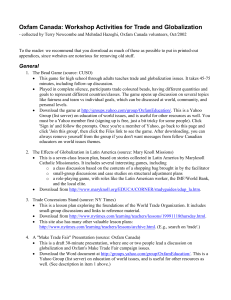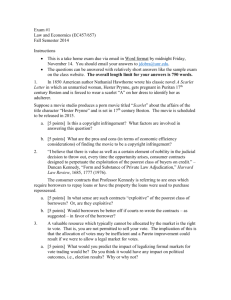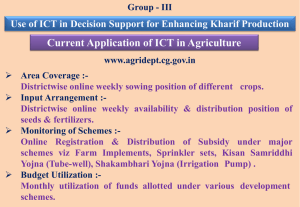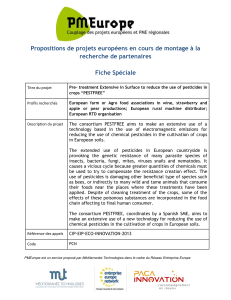WorkshopoutlineFoodSecurityandGlobalization_11
advertisement
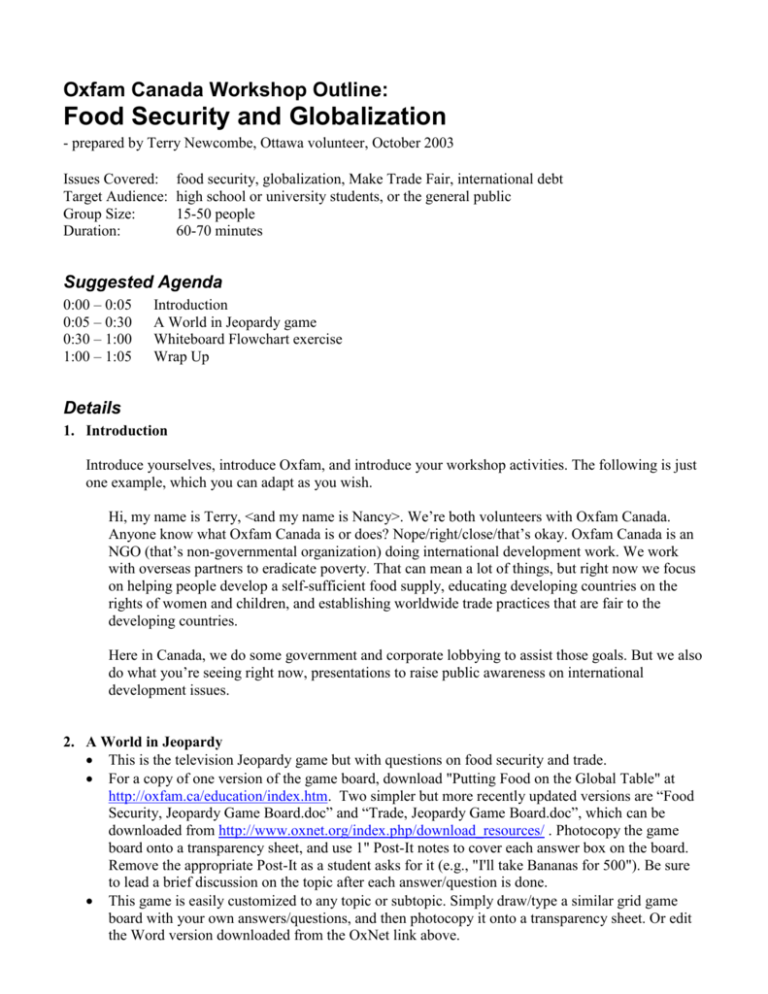
Oxfam Canada Workshop Outline:
Food Security and Globalization
- prepared by Terry Newcombe, Ottawa volunteer, October 2003
Issues Covered:
Target Audience:
Group Size:
Duration:
food security, globalization, Make Trade Fair, international debt
high school or university students, or the general public
15-50 people
60-70 minutes
Suggested Agenda
0:00 – 0:05
0:05 – 0:30
0:30 – 1:00
1:00 – 1:05
Introduction
A World in Jeopardy game
Whiteboard Flowchart exercise
Wrap Up
Details
1. Introduction
Introduce yourselves, introduce Oxfam, and introduce your workshop activities. The following is just
one example, which you can adapt as you wish.
Hi, my name is Terry, <and my name is Nancy>. We’re both volunteers with Oxfam Canada.
Anyone know what Oxfam Canada is or does? Nope/right/close/that’s okay. Oxfam Canada is an
NGO (that’s non-governmental organization) doing international development work. We work
with overseas partners to eradicate poverty. That can mean a lot of things, but right now we focus
on helping people develop a self-sufficient food supply, educating developing countries on the
rights of women and children, and establishing worldwide trade practices that are fair to the
developing countries.
Here in Canada, we do some government and corporate lobbying to assist those goals. But we also
do what you’re seeing right now, presentations to raise public awareness on international
development issues.
2. A World in Jeopardy
This is the television Jeopardy game but with questions on food security and trade.
For a copy of one version of the game board, download "Putting Food on the Global Table" at
http://oxfam.ca/education/index.htm. Two simpler but more recently updated versions are “Food
Security, Jeopardy Game Board.doc” and “Trade, Jeopardy Game Board.doc”, which can be
downloaded from http://www.oxnet.org/index.php/download_resources/ . Photocopy the game
board onto a transparency sheet, and use 1" Post-It notes to cover each answer box on the board.
Remove the appropriate Post-It as a student asks for it (e.g., "I'll take Bananas for 500"). Be sure
to lead a brief discussion on the topic after each answer/question is done.
This game is easily customized to any topic or subtopic. Simply draw/type a similar grid game
board with your own answers/questions, and then photocopy it onto a transparency sheet. Or edit
the Word version downloaded from the OxNet link above.
The following is one sample dialog you can use, but of course adapt it as you wish:
Okay, for the next 25 minutes I’m going to change my name to Alex, and you’re all in for
A World in Jeopardy. <Turn on overhead projector.> We don’t have any buzzers, so we’ll
change the game rules a bit.
I’m dividing the class into two teams, with these two rows being Team Left and these three
rows being Team Right. <It doesn’t matter if it isn’t exactly even.> <Draw two headings
on the blackboard, Team Left and Team Right.>
Listen carefully – here are the rules. Any one person in Team Left starts off by naming a
category and point value. As you can see, we’ve got six categories and five point ranges,
so you can ask for something like “I’ll have Bananas for 300, Alex.” I’ll remove the
sticker, and that one person (ALONE) has to provide the question for the displayed
answer. If they get it right, Team Left gets the points and someone else in the team gets the
next turn.
If they don’t get it right, it becomes an open question for the opposite team. They can
discuss it among themselves for a minute, and then someone has to offer the group’s
response. If they get it right, Team Right gets the points and someone else in the team gets
the next turn.
If they don’t get it either, it becomes an open question for the original team, with one
minute to discuss. If they get it right, Team Left gets the points and someone else in the
team gets the next turn. If they don’t get the right response, I’ll give the answer and Team
Right gets the next turn.
After each turn, be sure to give a brief ad-hoc comment on the significance of the question
covered. For example, if the question is about international debt, discuss the significance of having
such a large debt. This should just be a couple of sentences, but it is a very important aspect of the
game. Often you can say that the issue will be seen again in the second activity of this
presentation.
Team teach! One of you can handle the overhead and the whiteboard, while the other does the
post-question comments. Or you can take turns on the comments, depending on who knows the
issues for that question.
Wrap up the game half way through your total allotted time, giving notice that ‘this is the final
question’. Then say that we’ve brought up a lot of very important issues, and now we’re going to
look into some of those in more detail…
3. Whiteboard Flowcharting
This exercise has one or two facilitators drawing a flowchart on the whiteboard, based on student
answers to questions posed by the facilitators. The goal is to end up with a visual diagram of the
interactions between various issues. The chart's contents can vary with the specific topic
discussed, but we will give an example of how food security relates to globalization.
What You Say
What You Draw
a. Explain that up until fifty years ago, farmers around Monoculture
the world tended to grow the crops they wanted to
eat, and enough extra to sell for the things they
yields up
needed. Then science and farming mixed to create
this thing called the Green Revolution [Q. What
was this?], where it was shown that you can
produce huge yields by just focusing on a single
crop (e.g., corn, coffee, rice, sugar, bananas) and
using lots of chemical fertilizer and irrigation.
b. This indeed brought yields up (more food
produced). Poor countries rushed into monoculture yields up more export, more $
growing, resulting in [Q. in what?] more food to
sell and export, and thus more income to the
farmers and poor countries. Monoculture is thus
also known as cash crops.
c. But this had some bad side effects on the farmland.
[Q. What side effects?][Modify the flowchart
monoculture weakened soil
sequence based on answers.] One was that
monoculture drains the soil of nutrients. Rotating to
different crops each year was a common practice to
keep the soil healthy.
d. Over the years, this brought the yield down. It also
decreased the soil's resistance to weeds.
monoculture weakened soil
yields down more pests &
weeds yields further down
(circle)
e. [Q. So what did farmers do to bring the yields back
up?] They used more chemical fertilizer, pesticides, yields up
and herbicides.
f. But this also brought some bad news. [Q. What bad more fertilizers, pesticides, and
news?]
herbicides costs more money
less profit
fertilizers are short & harsh
nutrients soil gets weaker,
and can only grow thereafter
with increasingly stronger
amounts of fertilizer more
money (circle)
pesticides are indiscriminant,
killing insects and (through the
food chain) birds that are
otherwise helpful to the land
and the crops soil gets
weaker (circle)
g. Farmers are also encouraged to use more big farm
machinery to get better yields. [Q. What effects
does this have?]
h. After farmers around the world had become caught
in this cycle, the producers of fertilizers, pesticides,
and herbicides raised their prices. [Q. What effects
would this have?]
i. Around the same time this was happening, so many
poor countries had been encouraged to grow cash
crops for export to the first world countries that
there was now a surplus on the world market. [Q.
What does this cause?] This causes prices to drop.
(Side point: note that it is the poor countries
growing the raw materials at low profits, and the
rich countries producing the processed products
like chemical fertilizers at high profits.
j. [Q. How does this all affect the financial balance
between the first world/industrial countries and the
third world/developing countries?] The already
developed countries get stronger economically
(paying less for food and making more profit on
exported fertilizers, pesticides, and herbicides),
while the developing countries get weaker
economically.
k. [Q. What happens when the farmers can't sell
enough crops to pay their fert/pest/insecticide
costs?] This quickly gets to the point where farmers
can't afford to farm. [Q. So what can they do?]
They have to sell their farms (or often lose them
completely to debts), usually to large farming
businesses with ties to first world farming
industries ('agrobusinesses') more control of the
poor countries' economies gets transferred to the
first world businesses
l. [Q. How does this all affect the financial balance
between the first world/industrial countries and the
third world/developing countries?] This results in
more control of the poor countries' economies
being transferred to the first world businesses.
m. [Q. So what happens to the farmers after selling
their farms?] Often the farmers become hired
buy expensive farm equipment
less profits
farmers in poor countries
become tied into foreigncontrolled technologies &
businesses loss of self
control over farming industry
higher prices for fertilizer,
pesticides, herbicides
farmers had even less profit
some farmers couldn't afford
enough fert/pest/herbicides
yields stayed low
world surpluses prices drop
profits less (circle)
rich richer, poor poorer (circle)
can't afford to farm
sell or lose farms to
agrobusinesses
first world controls more
(circle)
hired workers lower pay, no
food to eat
workers of the agrobusinesses. [Q. Why is this
bad?] Now they get very low pay (due to the
surplus of available workers and the increased use
of machinery) and they don't have their own crops
anymore to feed their families.
n. Farmers and their families often have no choice but
to leave the countryside completely and move to
move to cities
the cities, looking for employment and food. Often unemployment slums
they can't find either due to overcrowded cities. [Q.
poor health and violence
What does this lead to?] This leads to
drains on social and economic
unemployment, slums, poor health, and violence.
systems
All are drains on the social and economic systems
of the country.
o. The country is now trying to keep up its exports
while having higher social and economic costs. It is country's choices directed by
increasingly having its choices directed by the big
agrobusinesses' needs
agrobusinesses that own more and more of the
making decisions to improve
farmland. [Q. Why is this such a bad thing?] These
the agrobusinesses, not the
businesses are often foreign controlled. The poor
country
countries end up making economic decisions based first world controls more
on what is best for the transnational agrobusinesses
(circle)
and not their own economy. Once again, the first
world's control over the poor countries increases.
The poor countries become low class workers
forced to stay at that level so that the first world
countries can keep their low food imports and high
processed-material exports. (Optionally, at this
point, you can get into how first world countries set
high tariffs on processed foods and goods, to keep
their dominance on these higher-profit markets.}
p. (Optionally, you can also bring up another path
when farmers lose their land. They cut down
rainforest, usually illegally, and plant crops. But
rainforest soil is a delicate balance formed over
thousands of years. Just 10-20 years of cattle
grazing, for example, can completely destroy that
land which once held hundreds of tree varieties, so
that it now only holds two or three types of low
brush.) (This can lead to an environmental
flowchart if desired.)
Run the exercise until you have about 10-15 minutes left in your presentation time slot. (You may
not get to all the above issues.) Then move to another whiteboard and say that this all sounds
pretty gloomy. What can be done to get the poor countries out of this dead end? Point out that
there are two kinds of solutions, those that can be done by governments and people in the
developing countries, and those that the students can do themselves.
In the former category, bring up solutions like
(a) The first world (WTO, World Bank, IMF) can better control world industries to avoid giant
surpluses.
(b) The first world can drop tariffs (import taxes) on processed foods, allowing poor countries to
develop food industries beyond simple farming (diversity and higher profits).
(c) Farmers can return to the model of many small family-owned farms producing multiple foods,
and rotating crops. This reduces need for chemical fertilizers, pesticides, and herbicides, while
also ensuring that farmers not growing enough to sell will at least have some food to eat. Many
first-world non-governmental agencies are involved in training farmers in sustainable agricultural
practices.
(d) First world agrobusinesses must recognize that the big picture requires thinking beyond
increasing their profits at all costs. It requires thinking beyond "we have to answer to our
stockholders". And the stockholders in turn have to realize the same. Many multinational
businesses are now making decisions to improve farmers' situations based on pressure put on them
by some of their own socially responsible stockholders. You and your parents can support such
socially responsible investing (SRIs).
In the category of what students can do, bring up actions like:
(a) Organize a group of students to have your school adopt a no-sweatshops buying policy.
Pressure on manufacturers of clothing and sports equipment to provide healthy environments and
fair wages to workers will help strengthen the countries providing those products, giving them
alternative economies to cash crops.
(b) Organize a group of students to commit your school cafeteria, and/or nearby coffee shops, to
sell at least one regular fair-trade brand of coffee, tea, and hot chocolate.
(c) Don't underestimate the power of writing letters, both individually and by starting up
campaigns to do so. Target the PM, your own MPs, the ministers responsible for the areas you'd
like change in, and corporations themselves.
(d) Raise funds for an NGO like Oxfam Canada. For example, from our website, www.oxfam.ca,
you can download the Hungry for Change kit, which gives you all you need to raise funds while
doing a one-day fasting. Oxfam America’s site, www.oxfamamerica.org, has an alternative
fundraiser package you can download, the Hunger Banquet Planning Kit.
When discussing what YOU can do specifically, discuss the common feeling of "It's hopeless,
we're just a few against the powerful." Give Margaret Mead's quote:" Never doubt that a small
group of thoughtful, committed citizens can change the world. Indeed, it's the only thing that ever
has." And then discuss who you're up against: governments and corporations. The governments
are supposed to be driven by the people, but the unofficial rule is that the loudest people count the
most – ask who that group is. Answer: corporations, since they pay millions to lobby governments
heavily. They also donate to governments heavily, both officially and under the table. Whose
policy would you support if you were the government? The one a bunch of individual voters ask
for, or the one asked for by the people who keep your party financially afloat and in power?
Conclusion: Canadians don't have as 'true' a democracy as we like to think. We allow corporations
to control the government by allowing such lobbying and donations. Solution: get those letters
going to put a cap on (or stop completely) corporate donations to political parties. And we can't
stop lobbying, as a valued part of our democracy, but we can have caps put on it so that the rich
corporations don't overcome the voices of the people.
4. Wrap Up
This can actually blend into the final section of the flowchart exercise above. Point out that we’ve
learned a lot of the causes of global hunger and global economy imbalances, perhaps asking the
students to highlight a few. Then end on a high note of taking positive action individually and
together. Thank everyone for their participation and wish them luck on their activities.
We would appreciate any feedback you have on this workshop. Please share it with
ottawavolunteers@oxfam.ca.
